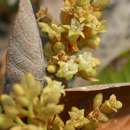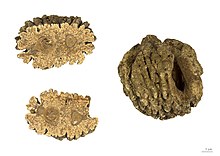en
names in breadcrumbs



Parinari is a genus of plant in the family Chrysobalanaceae.[2]
Species of genus Parinari are found in Subsaharan Africa from Senegal to Sudan and Kenya and south to Namibia and Natal; in Eastern Madagascar; from Indochina through Indonesia, New Guinea, northern Queensland, and the southwest Pacific; and in Central and South America from Costa Rica to Trinidad and southern Brazil.[1][2] The oldest fossils of Parinari fruits are from the early Miocene of Ethiopia, Panama, and Colombia.[2]
The genus is closely related to Neocarya.[3]
Parinari can be distinguished from other genera in Chrysobalanaceae by the following characteristics:[4]
As of May 2014 The Plant List recognises 42 accepted species (including infraspecific names):[5]
 Parinari montana - MHNT
Parinari montana - MHNT Parinari is a genus of plant in the family Chrysobalanaceae.
Species of genus Parinari are found in Subsaharan Africa from Senegal to Sudan and Kenya and south to Namibia and Natal; in Eastern Madagascar; from Indochina through Indonesia, New Guinea, northern Queensland, and the southwest Pacific; and in Central and South America from Costa Rica to Trinidad and southern Brazil. The oldest fossils of Parinari fruits are from the early Miocene of Ethiopia, Panama, and Colombia.
The genus is closely related to Neocarya.
Parinari can be distinguished from other genera in Chrysobalanaceae by the following characteristics:
zygomorphic floral symmetry 6-10 unilaterally-attached stamens per flower ovary at side or mouth of receptacle-tube leaf lower surface lanate and with hair-filled stomatal cavities and parallel secondaries closely spaced pair of glands on leaf petiole large, woody fruits